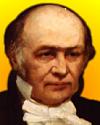 (source)
(source)
|
Sir William Rowan Hamilton
(4 Aug 1805 - 2 Sep 1865)
Irish mathematician.
|
Science Quotes by Sir William Rowan Hamilton (7 quotes)
To the Memory of Fourier
Fourier! with solemn and profound delight,
Joy born of awe, but kindling momently
To an intense and thrilling ecstacy,
I gaze upon thy glory and grow bright:
As if irradiate with beholden light;
As if the immortal that remains of thee
Attuned me to thy spirit’s harmony,
Breathing serene resolve and tranquil might.
Revealed appear thy silent thoughts of youth,
As if to consciousness, and all that view
Prophetic, of the heritage of truth
To thy majestic years of manhood due:
Darkness and error fleeing far away,
And the pure mind enthroned in perfect day.
Fourier! with solemn and profound delight,
Joy born of awe, but kindling momently
To an intense and thrilling ecstacy,
I gaze upon thy glory and grow bright:
As if irradiate with beholden light;
As if the immortal that remains of thee
Attuned me to thy spirit’s harmony,
Breathing serene resolve and tranquil might.
Revealed appear thy silent thoughts of youth,
As if to consciousness, and all that view
Prophetic, of the heritage of truth
To thy majestic years of manhood due:
Darkness and error fleeing far away,
And the pure mind enthroned in perfect day.
— Sir William Rowan Hamilton
In R. Graves, Life of W. R. Hamilton (1882), Vol. l, 696.
I regard it as an inelegance, or imperfection, in quaternions, or rather in the state to which it has been hitherto unfolded, whenever it becomes or seems to become necessary to have recourse to … the resources of ordinary algebra. [x, y, z, etc.]
— Sir William Rowan Hamilton
In Lectures on Quaternions: Containing a Systematic Statement of a New Mathematical Method (1853), 522.
i2 = j2 = k2 = ijk = - 1
[This representation was devised on 16th Oct 1843, and which he carved into a stone of Brougham Bridge, over the Royal Canal, Dublin. It has since worn away.]
[This representation was devised on 16th Oct 1843, and which he carved into a stone of Brougham Bridge, over the Royal Canal, Dublin. It has since worn away.]
— Sir William Rowan Hamilton
As written on a page in his note-book, shown in William Hamilton, Mathematical Papers (1967), Vol. 3, frontispiece.
On earth there is nothing great but man… in man there is nothing great but mind.
— Sir William Rowan Hamilton
In 'Appendix', Lectures on Metaphysics and Logic (1860), Vol. 2, 261. Attributed in a Latin form to Favorinus in Pico di Mirandola (1463–94) Disputationes Adversus Astrologiam Divinatricem.
The science of optics, like every other physical science, has two different directions of progress, which have been called the ascending and the descending scale, the inductive and the deductive method, the way of analysis and of synthesis. In every physical science, we must ascend from facts to laws, by the way of induction and analysis; and we must descend from laws to consequences, by the deductive and synthetic way. We must gather and group appearances, until the scientific imagination discerns their hidden law, and unity arises from variety; and then from unity must reduce variety, and force the discovered law to utter its revelations of the future.
— Sir William Rowan Hamilton
In On a General Method of Expressing the Paths of Light, & of the Planets, by the Coefficients of a Characteristic Function (1833), 7-8. [The spelling as “groupe” in the original text, has her been corrected to “group” to avoid an intrusive “sic”.]
These specimens, which I could easily multiply, may suffice to justify a profound distrust of Auguste Comte, wherever he may venture to speak as a mathematician. But his vast general ability, and that personal intimacy with the great Fourier, which I most willingly take his own word for having enjoyed, must always give an interest to his views on any subject of pure or applied mathematics.
— Sir William Rowan Hamilton
In R. Graves, Life of W. R. Hamilton (1882-89), Vol. 3, 475.
Who would not rather have the fame of Archimedes than that of his conqueror Marcellus?
— Sir William Rowan Hamilton
Letter (26 Aug 1822) to his Aunt Mary Hutton. In Robert Perceval Graves, Life of Sir William Rowan Hamilton (1882), 110.
Quotes by others about Sir William Rowan Hamilton (3)
Every man is ready to join in the approval or condemnation of a philosopher or a statesman, a poet or an orator, an artist or an architect. But who can judge of a mathematician? Who will write a review of Hamilton’s Quaternions, and show us wherein it is superior to Newton’s Fluxions?
In 'Imagination in Mathematics', North American Review, 85, 224.
In future times Tait will be best known for his work in the quaternion analysis. Had it not been for his expositions, developments and applications, Hamilton’s invention would be today, in all probability, a mathematical curiosity.
In Bibliotheca Mathematica (1903), 3, 189. As cited in Robert Édouard Moritz, Memorabilia Mathematica; Or, The Philomath’s Quotation-Book (1914), 178. [Note: Tait is Peter Guthrie Tait; Hamilton is Sir William Rowan Hamilton. —Webmaster]
An all-inclusive geometrical symbolism, such as Hamilton and Grassmann conceived of, is impossible.
In 'Über Vectoranalysis', Jahresbericht der Deutschen Mathematiker Vereinigung (1901), 5, 52. As translated in Robert Édouard Moritz, Memorabilia Mathematica; Or, The Philomath’s Quotation-book (1914), 200. From the original German, “Es kann keine allumfassende geometrische Symbolik geben, wie sie Grassmann und Hamilton sich dachten.”
See also:
- 4 Aug - short biography, births, deaths and events on date of Hamilton's birth.
- Sir William Rowan Hamilton, by Thomas L. Hankins. - book suggestion.
 In science it often happens that scientists say, 'You know that's a really good argument; my position is mistaken,' and then they would actually change their minds and you never hear that old view from them again. They really do it. It doesn't happen as often as it should, because scientists are human and change is sometimes painful. But it happens every day. I cannot recall the last time something like that happened in politics or religion.
(1987) --
In science it often happens that scientists say, 'You know that's a really good argument; my position is mistaken,' and then they would actually change their minds and you never hear that old view from them again. They really do it. It doesn't happen as often as it should, because scientists are human and change is sometimes painful. But it happens every day. I cannot recall the last time something like that happened in politics or religion.
(1987) -- 


